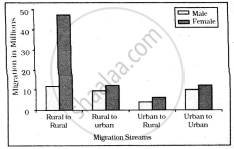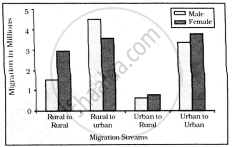Advertisements
Advertisements
प्रश्न
Answer the following question.
Compare, giving reasons, the J-shaped and S-shaped models of population growth of a species.
उत्तर
There are 2 models of population growth:
(i) The exponential growth
(ii) Logistic growth
(i) Exponential growth:
This growth occurs where the resources (food + space) are unlimited. The equation can be represented as
`(d"N")/(d"t")` = ( b - d ) x N
Let ( b - d ) = r
`(d"N")/(d"t")` = rN or Nt = N0ert
N = population size
Nt = population density after time t.
N0 = population density at time zero
r = growth rate
b =birth rate
d = death rate
In this growth, when N in relation to time is plotted on the graph, the curve becomes J-shaped.
(ii) Logistics growth model:
This is a realistic approach as the resources become limited at a certain point of time.

(a) J-shaped curve ⇒ exponential growth
(b) S-shaped curve ⇒ logistics growth
Every ecosystem has limited resources to support a particular maximum carrying capacity (K).
When N is plotted in relation to time t, a sigmoid-S-shaped curve is obtained & is also called as VERHULST-PEARL logistic growth.
The equation is:
`(d"N")/(d"t") = "rN" (("K" - "N"))/("K")`
N = population density at time t.
R = growth rate
K = carrying capacity.
APPEARS IN
संबंधित प्रश्न
In how many years India's population will be doubled?
What is the present annual growth rate of India?
Which of the following attributes has not been adversely affected by Age and Skill selective migration?
When the birth rate is more than the death rate between two points of time, it is known as ______
Study the given graph carefully and answer the following question:

Intra-state Migration by place of Last Residence Indicating Migration Streams India, 2011

Inter-state Migration by Place of Last Residence Indicating Migration Streams India, 2011
Who dominates the intra-state migration of short distances?
Which of the following pairs is not correctly matched?
Which of the following formula correctly depicts natural growth of population?
Assertion (A): Population of a region does not change.
Reason (R): Birth rate, death rate and migration affect the population of a region.
Assertion: Population of a region does not change.
Reason: Birth rate, death rate and migration affect the population of a region.
Assertion (A): Population of a region does not change.
Reasoning (R): Birth rate, death rate and migration affect the population of a region.
